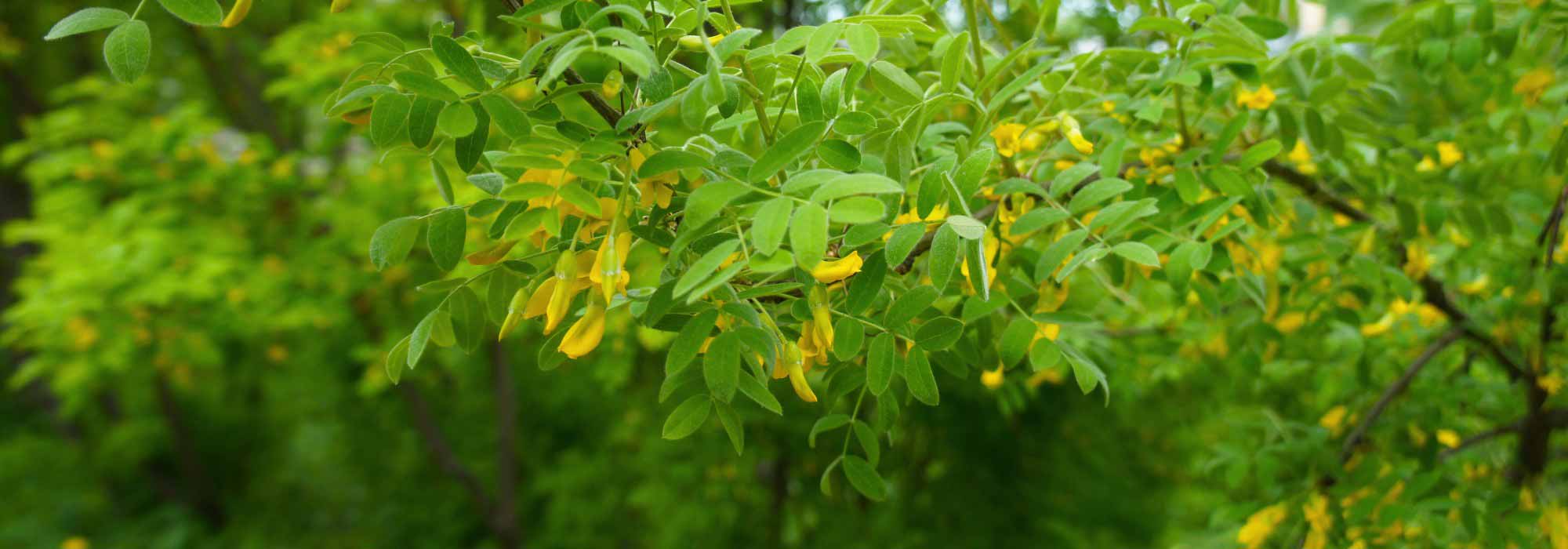
Caragana arborescens, Siberian pea shrub: planting, growing, and care
Contents
The Siberian Pea Tree in a Nutshell
- The Caragana boasts beautiful, delicate green foliage
- It flowers in spring with lovely clusters of yellow pea-like flowers
- Extremely hardy, this bush fears neither cold, drought, nor pollution
- It is easy to maintain and perfect for challenging areas or low-maintenance gardens
- It makes an excellent bush for free-form or defensive hedges in all regions
The word from our expert
The Caragana arborescens, also known as the Siberian pea bush or yellow acacia, is a hardy bush from the steppes of Central Asia, accustomed to extreme conditions. Easy to grow, it thrives even in poor soil, resisting summer drought as well as severe frosts. With rapid growth, it forms a small tree of about 4 to 5 m in all directions within a few years, depending on the variety. It stands out for its tender green deciduous foliage, light and finely divided into leaflets, and its yellow pea-like flowers that bloom in spring. These give way to pods containing edible peas. Particularly valuable in poor, compacted, or degraded soils, this bush is an essential choice for challenging areas or newly landscaped gardens. Low-maintenance and disease-resistant, it proves indispensable in gardens with poor-quality soil, offering a reliable solution for barren and damaged soils. It is ideal for informal hedges, serving as windbreaks or defensive barriers, as well as for small spaces thanks to its modest-sized varieties. Discover this hardy and undemanding tree, perfect for dry gardens where the soil lacks depth!
Botany
Botanical data
- Latin name Caragana arborescens
- Family Fabaceae
- Common name Siberian pea shrub, Siberian pea tree, Siberian yellow acacia, Pea tree
- Flowering April to May
- Height 1.70 to 5 m
- Exposure Sun
- Soil type Stony (poor and well-drained), dry
- Hardiness Down to -29°C
The Caragana arborescens, commonly known as Siberian pea shrub, Siberian yellow acacia, or Siberian pea tree, is a species belonging to the Fabaceae family, like the Black locust and Alfalfa. This bush is native to the cold and arid regions of Siberia and Mongolia, where it is traditionally used to form protective hedges around orchards. This function is explained by its ability to withstand strong winds and harsh environmental conditions, particularly severe winters, with an impressive tolerance to temperatures well below -20°C.
Its geographical range now extends far beyond its original zones. Thanks to its robustness and great adaptability, the Caragana arborescens has spread to Europe, North America, and other regions with extreme climates. The species type Caragana arborescens has given rise to interesting varieties, including the Caragana arborescens ‘Pendula’, a grafted variety with a weeping habit, and the Caragana arborescens ‘Walker’, another weeping variety distinguished by its very fine foliage.
The Siberian pea shrub is a deciduous, thorny bush, often wider than tall, which can form a small tree with low branching composed of multiple stems. Often wider than tall, it typically reaches 4.5 to 5 m in all directions with rapid growth. It adopts a flexible, rounded habit, supported by fine, slightly trailing branches. Some varieties feature a weeping habit, giving the tree an elegant and graceful appearance with branches trailing to the ground.
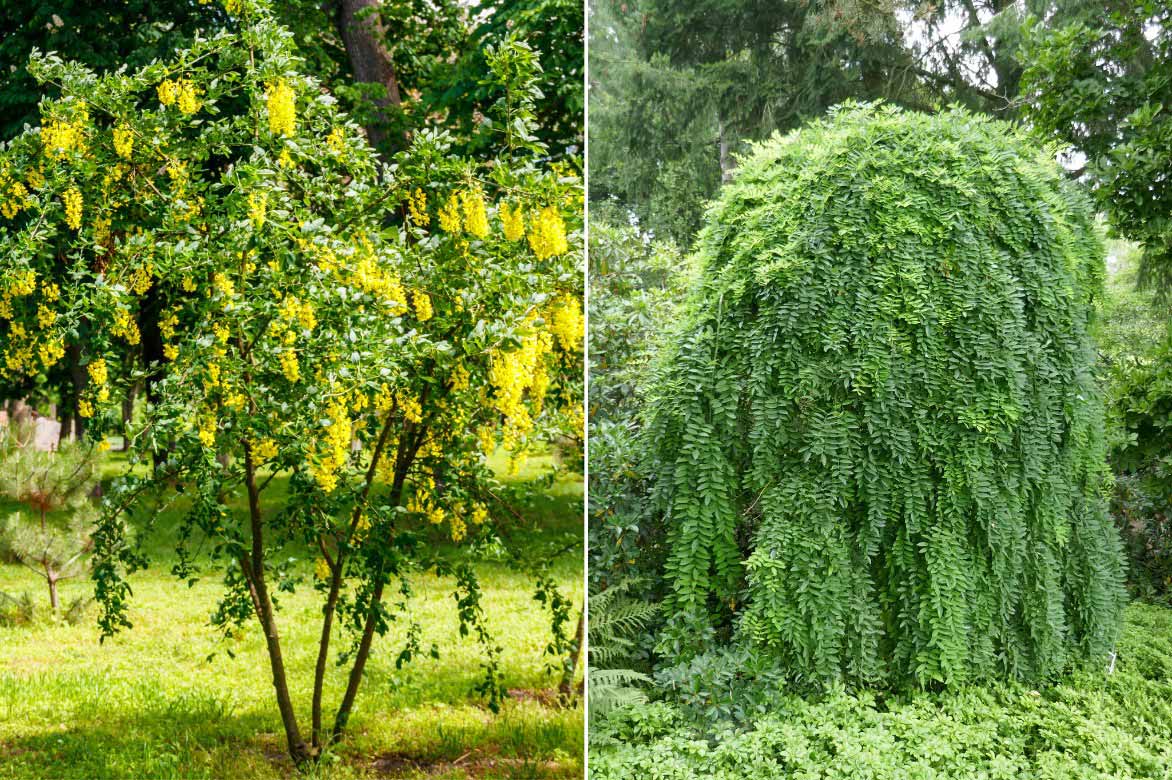
Depending on the variety, the Caragana takes on an upright or weeping habit. On the left, the Caragana arborescens (species type) and on the right, the ‘Pendula’ variety (photo: Wilrooij)
Its deciduous foliage, very dense and fresh light green, sometimes lemon yellow, resembles, depending on the variety, that of alfalfa or ferns. The leaves are composed of 5 to 7 pairs of small, ovate, slightly villous leaflets, about 2 cm long. Each leaf is equipped with small thorns at the base. In autumn, the foliage turns a golden yellow, offering a beautiful glow before falling as winter approaches.
Flowering occurs in spring, between April and May. It is rather discreet but charming, with small clusters of pea-shaped flowers, typical of the Fabaceae family, of a bright light yellow, which bloom on the previous year’s shoots. Although modest, this flowering is melliferous, attracting bees and other pollinators. The flowers are solitary or grouped in short clusters, reminiscent of those of acacias, hence the popular name “Siberian yellow acacia.”
After flowering, the tree produces fruits in the form of flat pods, measuring about 5 cm long, each containing 4 to 6 seeds. The pods, as well as the seeds, are edible and can be used in cooking.
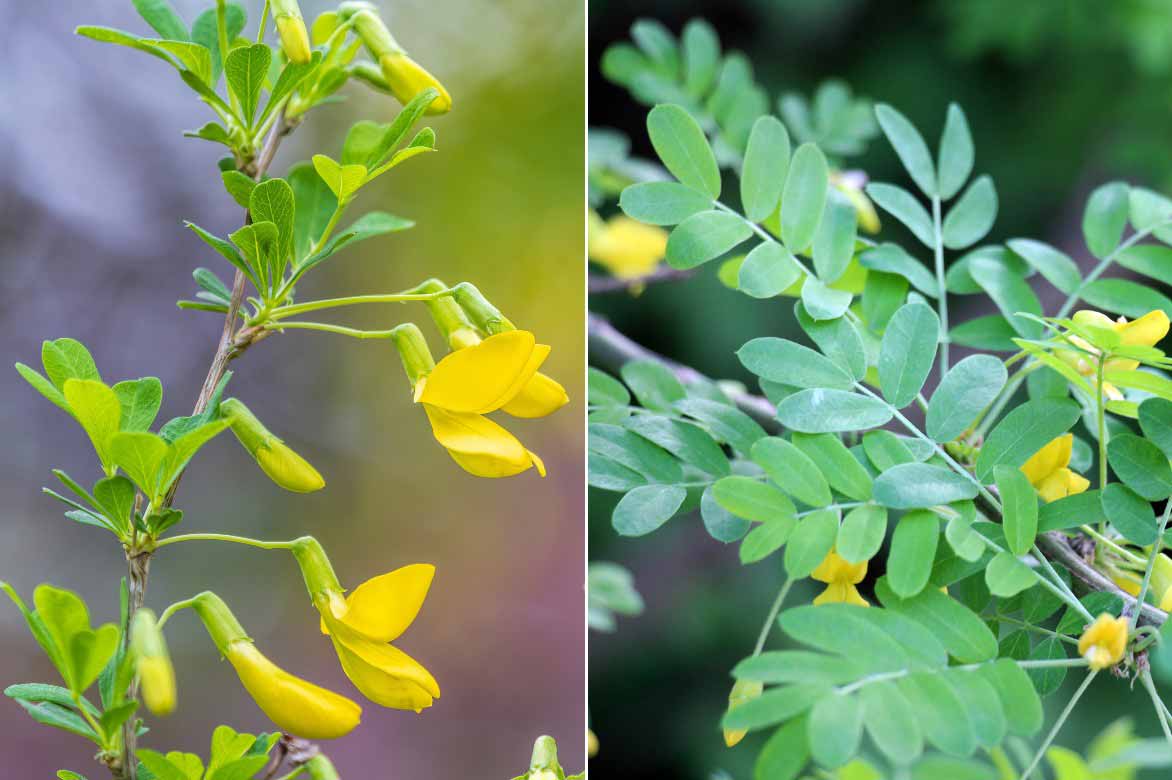
The flowering and foliage of the Caragana arborescens
Main species and varieties
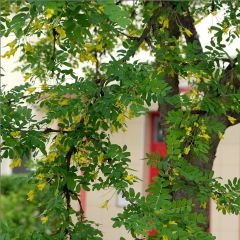
Caragana arborescens
- Flowering time May, June
- Height at maturity 4,50 m
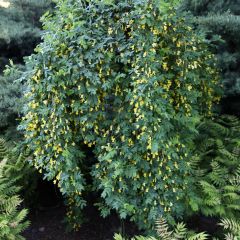
Caragana arborescens Pendula - Siberian Pea Tree.
- Flowering time May, June
- Height at maturity 1,70 m
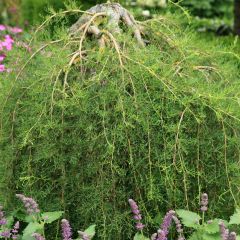
Caragana arborescens Walker - Siberian Pea Tree
- Flowering time May, June
- Height at maturity 4 m

Caragana arborescens Lutescens - Siberian pea tree
- Flowering time May, June
- Height at maturity 6,50 m
Discover other Caragana - Siberian Pea Tree
View all →Available in 1 sizes
Available in 1 sizes
Available in 2 sizes
Available in 1 sizes
Planting the Caragana arborescens
Where to Plant the Yellow Acacia?
The Siberian Pea Tree is one of the hardiest and most undemanding plants in existence. Hardy well beyond -20°C (down to -29°C), it acclimatises to all our regions. It can adapt to a wide variety of soils, whether slightly acidic, very chalky, or poor. However, it does not appreciate waterlogged soils, preferring well-drained ground. Avoid therefore heavy, clay soils that retain too much moisture. Its deep root system allows it to survive in drought conditions once established. This robustness makes it a preferred choice for regions with harsh climates or for low-maintenance gardens. It prefers sunny or very lightly shaded spots. A good exposure to sunlight will encourage more abundant flowering.
The Siberian Pea Tree is suitable for both small and large gardens. It naturally finds its place in a flowering hedge, free or defensive in neglected areas of the garden, or as a standalone specimen for cultivars with an attractively weeping silhouette.
When to Plant It?
The best time to plant Caragana arborescens is in autumn, in regions with hot, dry summers, or at the beginning of spring, in cool to cold regions. This gives it time to establish roots before the summer heat or winter frosts.
How to Plant a Siberian Pea Tree?
As it prefers poor or stony soils, overly fertile soil, as is often the case with Fabaceae, would encourage foliage growth at the expense of flowering. Due to its deep root system, avoid moving it once planted. The smaller varieties are ideal for container cultivation, particularly in urban gardens or on terraces. However, in a container, it will need more regular watering from spring until early autumn.
- Dig a planting hole 2 to 3 times wider than the root ball and as deep as the root ball (approximately 40 to 60 cm). This will allow the roots to spread.
- Hydrate the root ball by soaking it in water for 10 to 15 minutes.
- Position the bush in the centre of the hole, ensuring the collar is level with the soil.
- Plant in a mixture of garden soil, coarse sand or gravel, and leaf compost.
- Backfill, lightly firming the soil to avoid air pockets.
- Water generously after planting.
- Spread a layer of mulch around the base of the bush to retain moisture and suppress weeds, avoiding direct contact with the trunk.
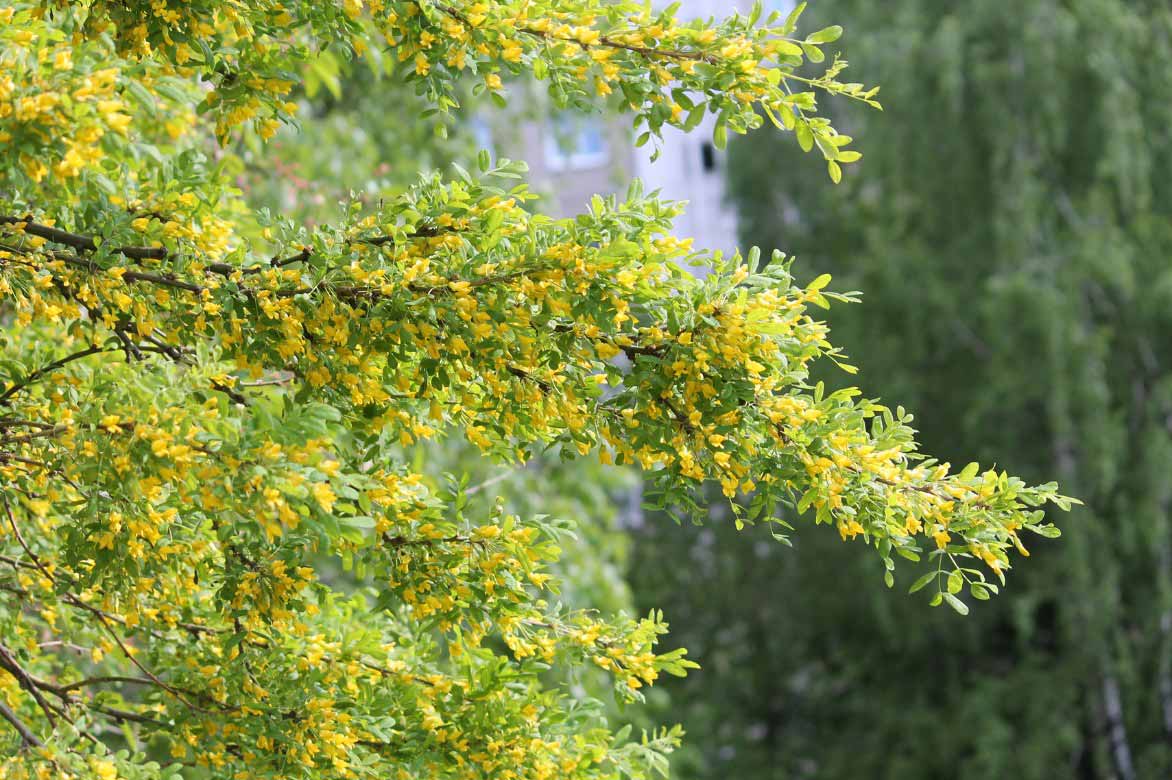
Maintenance and Pruning of the Caragana
The Caragana arborescens is a very hardy and low-maintenance bush, requiring little attention once well established. Maintain regular watering during the first two summers after planting to encourage good root development. Subsequently, the Siberian Peashrub will only need watering during prolonged dry spells. Its deep root system allows it to withstand drought once well established. It adapts to poor soils, so regular fertilisation is unnecessary. A light application of compost in early spring can, however, stimulate growth and flowering, though this remains facultative. Renew the mulch each year in spring to retain soil moisture and suppress weed competition, especially if your region is prone to dry summers.
The Siberian Peashrub is highly resistant to diseases and pests. However, watch for signs of root rot if the soil is waterlogged.
Pruning is not necessary. In spring, after flowering, simply remove dead, damaged, or diseased branches to keep the bush healthy. For weeping varieties, trim back any branches that touch the ground or cross over each other to maintain an elegant shape and an open habit.
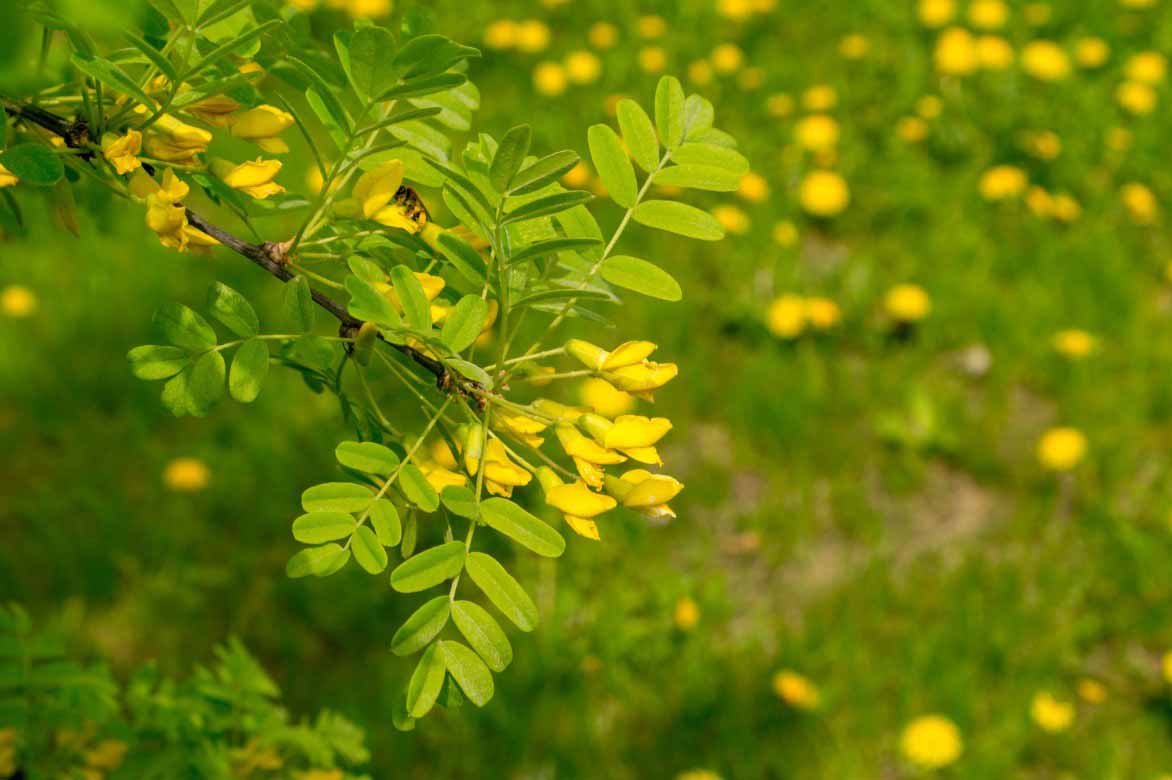
How to propagate Caragana?
Sowing is the most common technique, but propagation by cuttings is ideal for propagating specific varieties such as pendulous forms. You will need to wait between 3 and 5 years to see the young plants flower.
Sowing
Sowing is the most common method for propagating the Siberian Pea Tree. It does not necessarily produce specimens identical to the parent plant. The tree’s pods contain seeds that can be harvested in late summer or autumn. Wait until the pods turn brown and begin to open before harvesting them. To increase the germination rate of the seeds, it is recommended to scarify them (lightly scratch their coating with sandpaper) and soak them in warm water for 24 hours before sowing.
- Sow the seeds in a mixture of light compost and sand, pressing them about 1 cm deep.
- Place the pots or seed trays in a sunny spot.
- Keep the substrate slightly moist until germination, which occurs in about 2 to 3 weeks.
- When the young plants have 4 to 6 leaves, you can transplant them into the ground the following spring.
Propagation by Cuttings
Propagation by cuttings is another simple method for multiplying the Caragana, especially for pendulous varieties. It is usually carried out in late summer (August-September) on semi-hardwood, i.e., stems that have begun to turn into hard wood.
- Choose vigorous stems about 15 cm long. Cut just below a node (the point where the leaf is attached to the stem) and remove the leaves from the lower half.
- Plant the cuttings in a mixture of sand and compost in equal parts. Insert them one-third of their length into the substrate.
- Place the cuttings in a bright spot, but out of direct sunlight.
- Maintain regular moisture (without excess). Root formation takes about 6 to 8 weeks.
- Rooted cuttings can be transplanted into the ground the following spring.
How to pair Caragana?
The Siberian Pea Tree is suitable for both small and large gardens. Versatile, it naturally finds its place in a flowering hedge or defensive hedge, in an English-style border, or as a standalone specimen in a pot on the terrace, depending on the variety. Its robustness and light foliage make it an excellent companion for other undemanding and resilient bushes, perfect for bringing life and light to the most challenging corners of the garden.
It integrates perfectly into hedges alongside equally robust bushes like the Cotinus, whose purple or golden foliage creates a lovely contrast with the flowering of the Caragana, or shrubby honeysuckles (Lonicera tatarica and Lonicera fragrantissima). It also pairs well with other, less vigorous Fabaceae like the Coronilla glauca. The Caragana arborescens is also excellent for creating defensive hedges. For a striking contrast, plant it next to bushes with purple foliage like the Berberis thunbergii ‘Atropurpurea’. The Vitex, Sophora davidii, Buddleias, Phillyrea angustifolia, and Rhamnus alaternus ‘Argenteovariegata’ are other undemanding bushes that adapt well to dry and poor soils, making excellent companions.
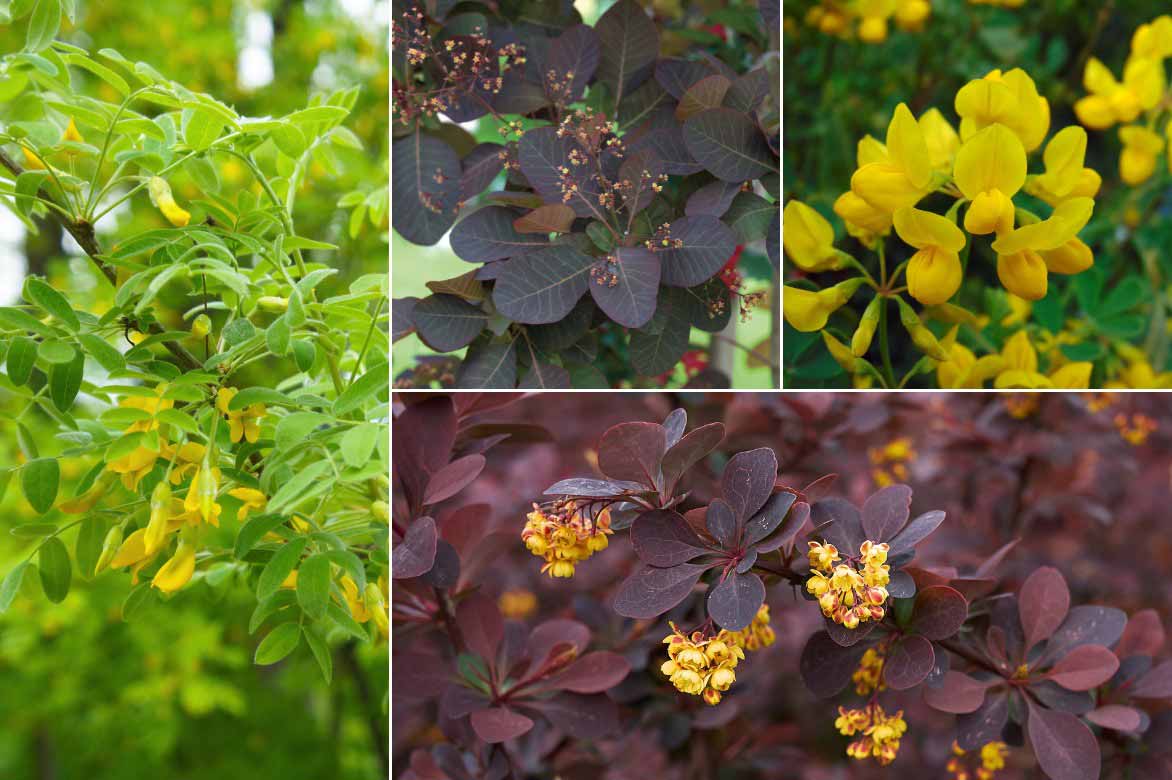
To highlight the Caragana, don’t hesitate to play with contrasts by pairing it with purple foliage. Caragana arborescens, Cotinus coggygria ‘Grace’, Coronilla valentina ‘Glauca’ and Berberis thunbergii ‘Atropurpurea’
The Caragana can also be planted within borders alongside small, undemanding bushes suited to drought conditions and full sun. For example, at its base, you can plant rockroses, lavenders, perovskia, and shrubby sages that flower all summer. In a yellow and blue border, it will look stunning alongside blue rosemary, creeping ceanothus, or grape hyacinths. In small spaces or pots, it pairs well with variegated ground covers like Vinca major ‘Variegata’, ivies, or small blue-flowering sages.
Did you know?
The pods, seeds, and flowers of Caragana arborescens are edible. The young pods can be harvested before their ripeness, then cooked and consumed like green beans. They are tender and have a mild vegetal flavour. The seeds, once ripe, can be used like peas or lentils. Rich in protein, they can be boiled or roasted. As for the flowers, they can be eaten raw. Their sweet and slightly sugary taste enhances salads. However, it is important to note that this consumption remains marginal, and it is advisable to taste in small quantities to check individual tolerance.
Useful resources
- Discover our article “Flowering Hedge: Which Bushes to Plant, When and How?”
- Explore our wide range of bushes and flowering hedge kits
- To learn all about the different packaging options for bushes: “Hedge Bushes: Naked Roots, Root Balls, Buckets, Potted Bushes… What to Choose?”
- To ensure successful hedge planting, check out our guide: “How to Plant a Hedge”
- Find our entire range of defensive hedge bushes
- Subscribe!
- Contents

































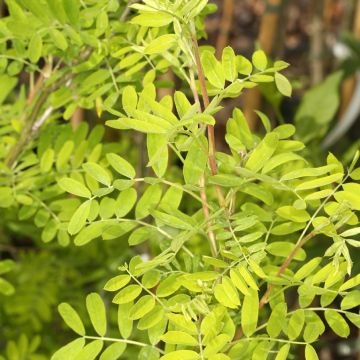


Comments